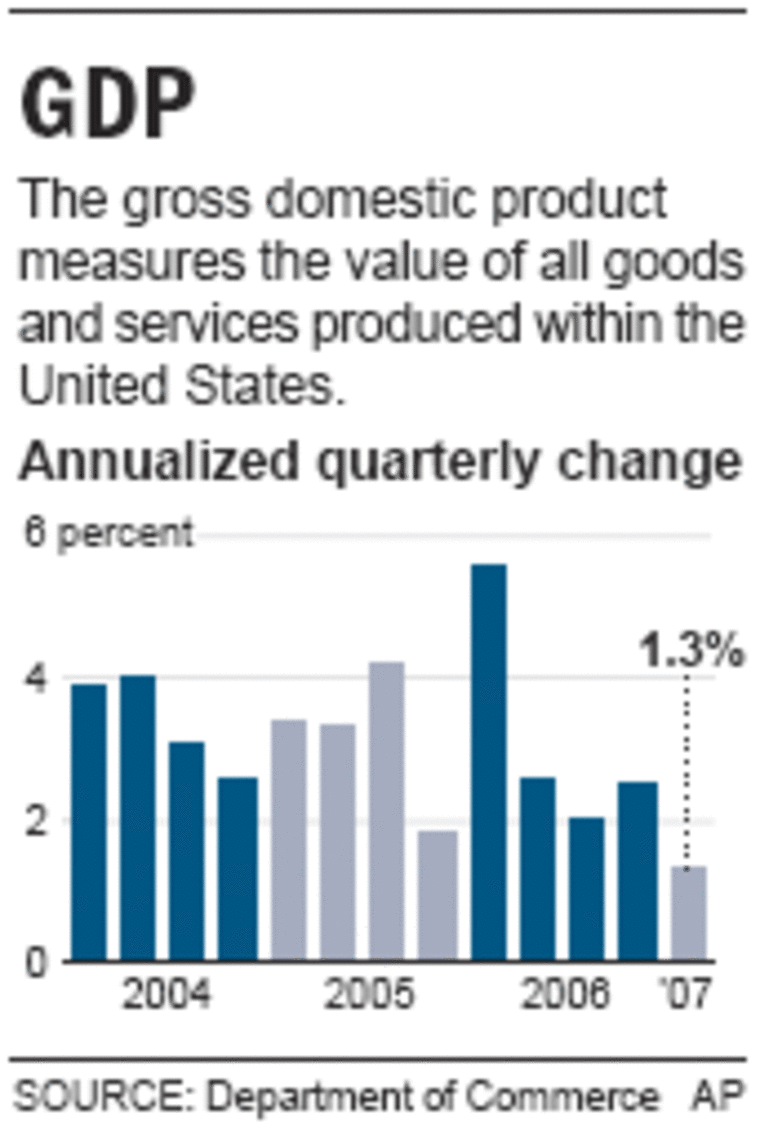The worst economic growth in four years is raising concern that troubles in the U.S. housing market will spread and throw the country into a recession before the year is out.
The economy practically crawled at a 1.3 percent pace in the opening quarter of 2007, the Commerce Department reported Friday. That was even weaker than the sluggish 2.5 percent rate in the closing quarter of last year.
The main culprit in the slowdown: the housing slump, which made some businesses act cautiously. The bloated trade deficit also played a role.
Consumers largely carried the economy in the first quarter. But will they stay resilient in light of the troubled housing market, fallout from risky mortgages and rising energy prices?
“The No. 1 question is can the consumer continue to play Atlas while the housing market crumbles around him?” said Richard Yamarone, economist at Argus Research. Others worry about businesses’ appetite to spend and invest — also important ingredients for a healthy economy.
Friday’s report brought some of these uncertainties to the fore. For now, though, economists believe the risk of a recession is low. Former Federal Reserve Chairman Alan Greenspan has put the chance of a recession this year at one in three.
Federal Reserve Chairman Ben Bernanke, however, has said he doesn’t believe the economic expansion, now in its sixth year, is in danger of fizzling out. Neither does the Bush administration.

The reading on gross domestic product in the first quarter was the weakest since a 1.2 percent pace in the opening quarter of 2003. GDP measures the value of all goods and services produced within the United States and is considered the best barometer of the country’s economic fitness.
The performance was even weaker than the 1.8 percent economists had forecast.
“The economy went through a very soggy period,” said Lynn Reaser, chief economist at Bank of America’s Investment Strategies Group. “The biggest risk to the economy is if the housing market doesn’t stabilize. That could force consumers and businesses to cut back sharply in spending. Those risks seem to be limited at this juncture,” she said.
Even though the economy slowed in the first quarter, inflation picked up. That could complicate the Fed’s work of keeping the economy and inflation on an even keel. “This is a knife’s edge scenario,” observed John Silvia, chief economist at Wachovia Economics Group.
An inflation gauge tied to the GDP report and closely watched by the Fed showed that core prices — excluding food and energy — rose at a rate of 2.2 percent in the first quarter, up from 1.8 percent in the fourth quarter.
Republicans and Democrats had divergent views of the GDP report.
“We knew that the housing market would go through an adjustment. The positive news here is that our economy has been able to grow in spite of that very sharp reduction,” Commerce Secretary Carlos Gutierrez said in an interview with The Associated Press.
But Sen. Charles Schumer, D-N.Y., called the sick housing market and the swollen trade deficit — which played in the first-quarter’s slowdown — “body blows” to the economy that “must be countered by sound economic policy from the Bush administration.”
The biggest factor behind the first quarter slowdown was the crumbling housing market. Investment in home building was cut by 17 percent on an annualized basis. Such investment had been slashed at an even deeper 19.8 percent pace in the fourth quarter.
“The report tells me housing is probably going to be in a more prolonged and deeper recession,” said Stuart Hoffman, chief economist at PNC Financial Services Group.
Weak investment by businesses in inventories also held back GDP. So did the trade deficit, shaving 0.52 percentage point off GDP.
Another negative factor was a 6.6 percent drop, on an annualized basis, in federal defense spending.
However, consumers whose shopping is indispensable to a booming economy boosted their spending at a 3.8 percent pace. That was a solid showing although it was slightly weaker than the 4.2 percent rate in the fourth quarter.
A key reason consumers have remained resilient, even in the face of the painful housing slump, is that the jobs markets has managed to stay in good shape.
The nation’s unemployment rate dropped in March to 4.4 percent, matching a five-year low. However, economists predict that rate will climb — perhaps to close to 5 percent by the end of this year — as economic activity cools.
In other economic news, employers’ costs to hire and retain workers grew 0.8 percent in the first quarter, down slightly from a 0.9 percent increase in the fourth quarter, the Labor Department reported.
Wages and salaries went up 1.1 percent, a figure that hasn’t been higher since 2001. That’s good news for workers and should support consumer spending. Benefit costs, however, edged up just 0.1 percent, the least since the first quarter of 1999.